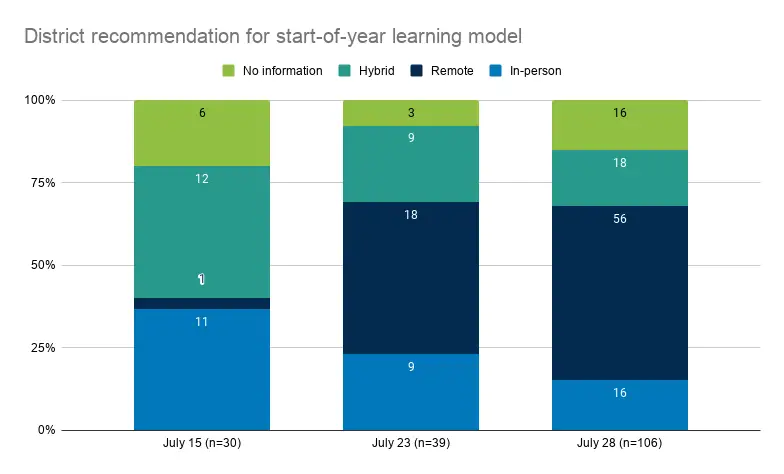Dozens more districts have released draft reopening plans and are making final recommendations for their start-of-year learning model. After reviewing the latest plans from 106 districts and 18 charter management organizations—which serve over 10 million students—it’s clear that although many districts had been planning to open in-person on a regular or hybrid/rotating schedule, their plans have changed.
Just 16 of 106 (15 percent) districts are still committed to opening the school year with in-person learning. These decisions represent a seismic shift over just a few weeks, and appear to be primarily in direct response to directives or warnings from county or state health officials.
While many districts hope to delay the start of an eventual return to in-person instruction, at least the first few weeks of the 2020-21 school year promise to be a return to remote learning.
Similarly, none of the 18 charter management organizations (CMOs) we reviewed plan to open the year in-person full-time. Six plan to open remotely, one plans to open with a hybrid model, and eleven have not posted information about which learning model they will follow.
Districts, which originally prioritized in-person returns, are moving to remote learning for rational reasons. Where health conditions are steadily declining (as of July 26, 38 of 50 states have a virus transmission rate above 1 percent) staff and parents are voicing more urgent concern for their safety.
At Highline Public Schools in Washington state, 35 percent of the staff identify as being in a high-risk group for COVID-19 infection and 29 percent live with someone in a high-risk group. Denver Public Schools made the decision to go remote, in part, after surveys of students, families, and teachers revealed that communities of color were more likely to voice concern about the risks associated with returning to school. The combination of these equity concerns and updated health modeling led the district to delay in-person instruction.
The grim reality districts face stands in stark contrast to the HEALS Act unveiled yesterday in the U.S. Senate. The bill proposes to withhold two-thirds of federal stimulus dollars from school systems that do not open in-person. The financial penalties appear unlikely to influence these districts’ decisions and may disproportionately penalize communities of color and other vulnerable populations who need access to the additional federal dollars to pay for critical educational expenses—from teacher training and technology access to tutoring initiatives that might stem the learning losses students experienced last spring.
While remote learning did not appear to be a focus of early summer planning, it is now. And it looks like districts have taken feedback from parents and stakeholders to offer more remote instruction. Commonly, districts we reviewed indicated they would provide more live instruction, more consistency, and more teacher feedback.
As one would expect, almost all districts are describing how curriculum and instruction will be delivered remotely. Of the 80 districts providing detail on their remote learning plans, 93 percent (74 of 80) set expectations for schools to provide remote instruction, and 84 percent (67 of 80) explain how they will offer remote curriculum.
Based on 80 of 106 districts that have provided information on their remote learning plans.
The health challenges districts face continue to accumulate. Yesterday, Florida reported over 30,000 cases of COVID-19 in children under the age of 17, and a 23 percent increase in child hospitalizations. Alarmingly, 12 of the 16 districts we reviewed that are still planning to open in-person are in COVID-19 hotspots with up to 100 percent increases in reported cases last week, including five districts in Florida.
There are valid reasons to advocate in-person reopening. The remote learning many families experienced last spring, especially in rural and low-income communities, fell far short of what public schools normally provide. And parents may need a place for their children to go during the day in order to return to work. But federal policymakers must find ways to help school systems address these realities—without putting the health and safety of their communities at risk.
Rather than exhorting districts to open against the advice of local health officials and parent and teacher concerns, lawmakers should instead ensure that every student can learn successfully in whatever learning model local health officials determine is safe. Funding for technology, wifi, tutoring, and innovative parent- and community-led solutions like Oakland REACH’s virtual hub will do far more to keep students learning than funding tied to reopening physical classrooms, which is out of touch with the current public health reality.







